Comprehensive Marketing Report: Tesla's Market Dynamics and Strategy
VerifiedAdded on 2022/10/19
|11
|2308
|349
Report
AI Summary
This report offers a comprehensive marketing analysis of Tesla, examining its market positioning, particularly in the competitive global automotive sector. It delves into Tesla's innovative approach to electric mobility, highlighting its unique features and competitive advantages. The analysis covers market trend analysis, emphasizing Tesla's position as a challenger in the electric vehicle market. The report identifies Tesla's niche features, including sustainability, automotive driving technology, and safety ratings. Furthermore, it evaluates the customer adoption process, offering recommendations for enhancing brand awareness and reaching broader customer segments. The report also discusses Tesla's pricing and distribution strategies, suggesting adjustments to increase market share. The report concludes with recommendations for Tesla to achieve global market leadership, emphasizing the importance of strategic implementation.

Running head: MARKETING MANAGEMENT
Marketing management
Name of the student
Name of the university
Author note
Marketing management
Name of the student
Name of the university
Author note
Paraphrase This Document
Need a fresh take? Get an instant paraphrase of this document with our AI Paraphraser
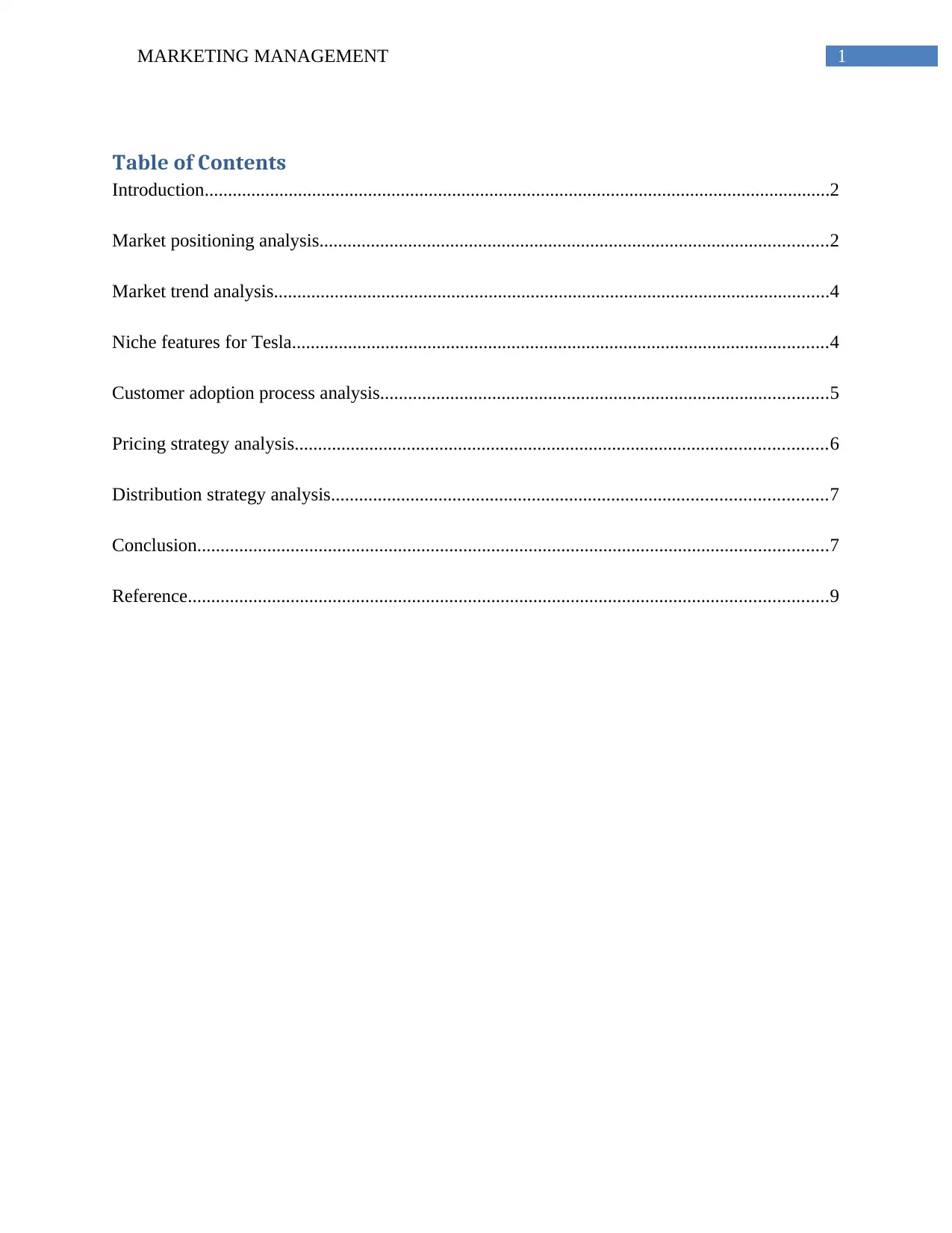
1MARKETING MANAGEMENT
Table of Contents
Introduction......................................................................................................................................2
Market positioning analysis.............................................................................................................2
Market trend analysis.......................................................................................................................4
Niche features for Tesla...................................................................................................................4
Customer adoption process analysis................................................................................................5
Pricing strategy analysis..................................................................................................................6
Distribution strategy analysis..........................................................................................................7
Conclusion.......................................................................................................................................7
Reference.........................................................................................................................................9
Table of Contents
Introduction......................................................................................................................................2
Market positioning analysis.............................................................................................................2
Market trend analysis.......................................................................................................................4
Niche features for Tesla...................................................................................................................4
Customer adoption process analysis................................................................................................5
Pricing strategy analysis..................................................................................................................6
Distribution strategy analysis..........................................................................................................7
Conclusion.......................................................................................................................................7
Reference.........................................................................................................................................9
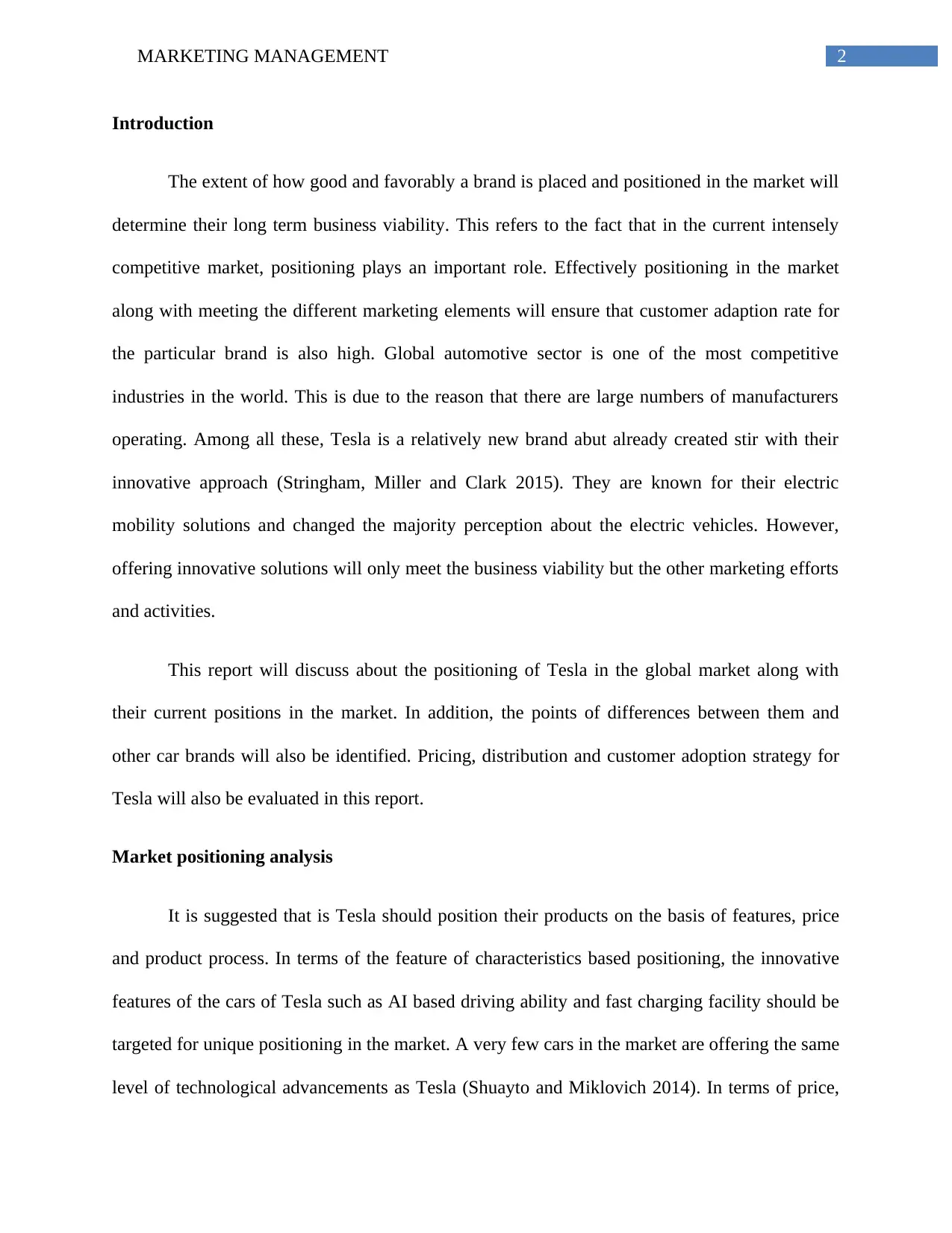
2MARKETING MANAGEMENT
Introduction
The extent of how good and favorably a brand is placed and positioned in the market will
determine their long term business viability. This refers to the fact that in the current intensely
competitive market, positioning plays an important role. Effectively positioning in the market
along with meeting the different marketing elements will ensure that customer adaption rate for
the particular brand is also high. Global automotive sector is one of the most competitive
industries in the world. This is due to the reason that there are large numbers of manufacturers
operating. Among all these, Tesla is a relatively new brand abut already created stir with their
innovative approach (Stringham, Miller and Clark 2015). They are known for their electric
mobility solutions and changed the majority perception about the electric vehicles. However,
offering innovative solutions will only meet the business viability but the other marketing efforts
and activities.
This report will discuss about the positioning of Tesla in the global market along with
their current positions in the market. In addition, the points of differences between them and
other car brands will also be identified. Pricing, distribution and customer adoption strategy for
Tesla will also be evaluated in this report.
Market positioning analysis
It is suggested that is Tesla should position their products on the basis of features, price
and product process. In terms of the feature of characteristics based positioning, the innovative
features of the cars of Tesla such as AI based driving ability and fast charging facility should be
targeted for unique positioning in the market. A very few cars in the market are offering the same
level of technological advancements as Tesla (Shuayto and Miklovich 2014). In terms of price,
Introduction
The extent of how good and favorably a brand is placed and positioned in the market will
determine their long term business viability. This refers to the fact that in the current intensely
competitive market, positioning plays an important role. Effectively positioning in the market
along with meeting the different marketing elements will ensure that customer adaption rate for
the particular brand is also high. Global automotive sector is one of the most competitive
industries in the world. This is due to the reason that there are large numbers of manufacturers
operating. Among all these, Tesla is a relatively new brand abut already created stir with their
innovative approach (Stringham, Miller and Clark 2015). They are known for their electric
mobility solutions and changed the majority perception about the electric vehicles. However,
offering innovative solutions will only meet the business viability but the other marketing efforts
and activities.
This report will discuss about the positioning of Tesla in the global market along with
their current positions in the market. In addition, the points of differences between them and
other car brands will also be identified. Pricing, distribution and customer adoption strategy for
Tesla will also be evaluated in this report.
Market positioning analysis
It is suggested that is Tesla should position their products on the basis of features, price
and product process. In terms of the feature of characteristics based positioning, the innovative
features of the cars of Tesla such as AI based driving ability and fast charging facility should be
targeted for unique positioning in the market. A very few cars in the market are offering the same
level of technological advancements as Tesla (Shuayto and Miklovich 2014). In terms of price,
⊘ This is a preview!⊘
Do you want full access?
Subscribe today to unlock all pages.

Trusted by 1+ million students worldwide
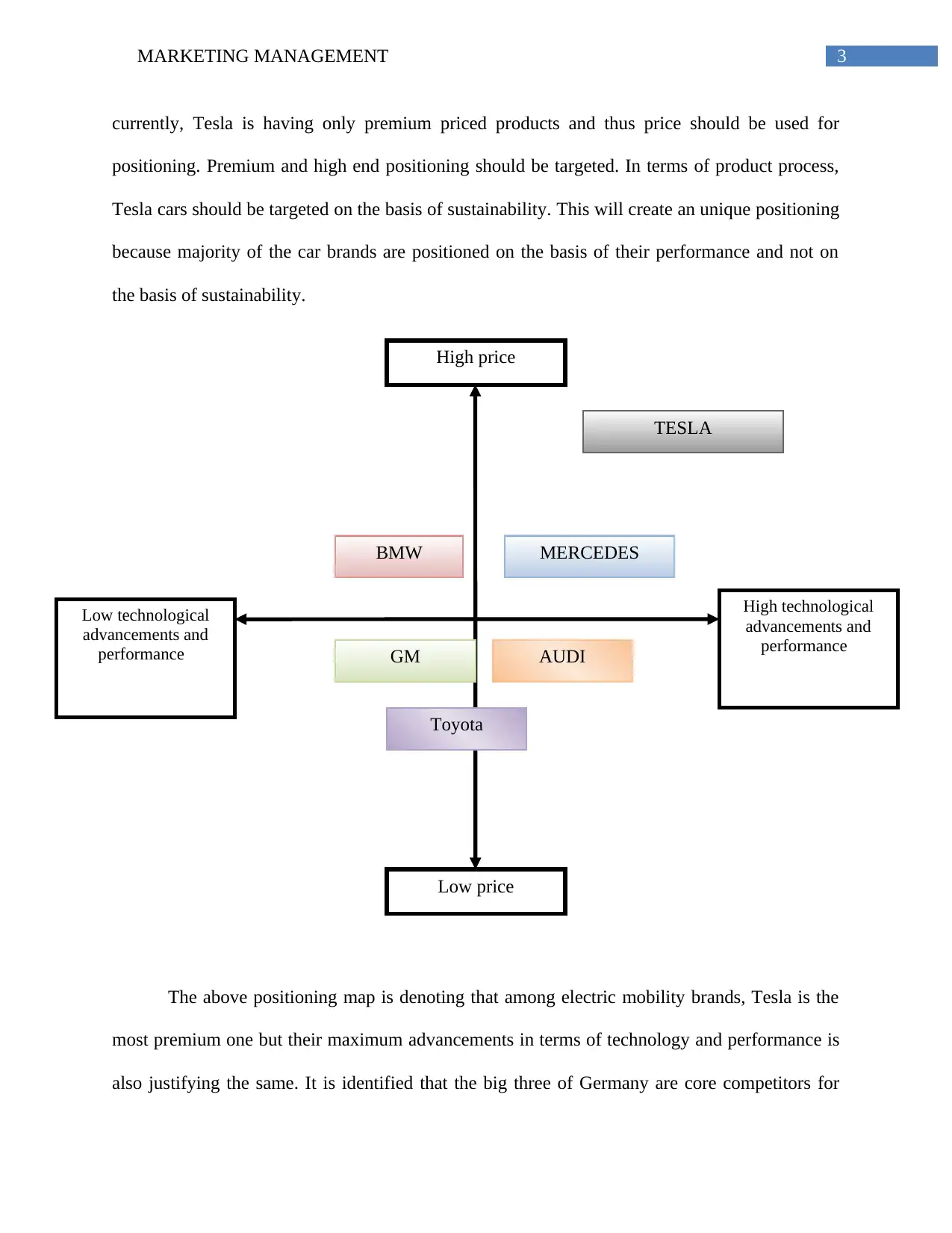
3MARKETING MANAGEMENT
High price
Low price
Low technological
advancements and
performance
High technological
advancements and
performance
AUDI
MERCEDES
TESLA
BMW
Toyota
GM
currently, Tesla is having only premium priced products and thus price should be used for
positioning. Premium and high end positioning should be targeted. In terms of product process,
Tesla cars should be targeted on the basis of sustainability. This will create an unique positioning
because majority of the car brands are positioned on the basis of their performance and not on
the basis of sustainability.
The above positioning map is denoting that among electric mobility brands, Tesla is the
most premium one but their maximum advancements in terms of technology and performance is
also justifying the same. It is identified that the big three of Germany are core competitors for
High price
Low price
Low technological
advancements and
performance
High technological
advancements and
performance
AUDI
MERCEDES
TESLA
BMW
Toyota
GM
currently, Tesla is having only premium priced products and thus price should be used for
positioning. Premium and high end positioning should be targeted. In terms of product process,
Tesla cars should be targeted on the basis of sustainability. This will create an unique positioning
because majority of the car brands are positioned on the basis of their performance and not on
the basis of sustainability.
The above positioning map is denoting that among electric mobility brands, Tesla is the
most premium one but their maximum advancements in terms of technology and performance is
also justifying the same. It is identified that the big three of Germany are core competitors for
Paraphrase This Document
Need a fresh take? Get an instant paraphrase of this document with our AI Paraphraser
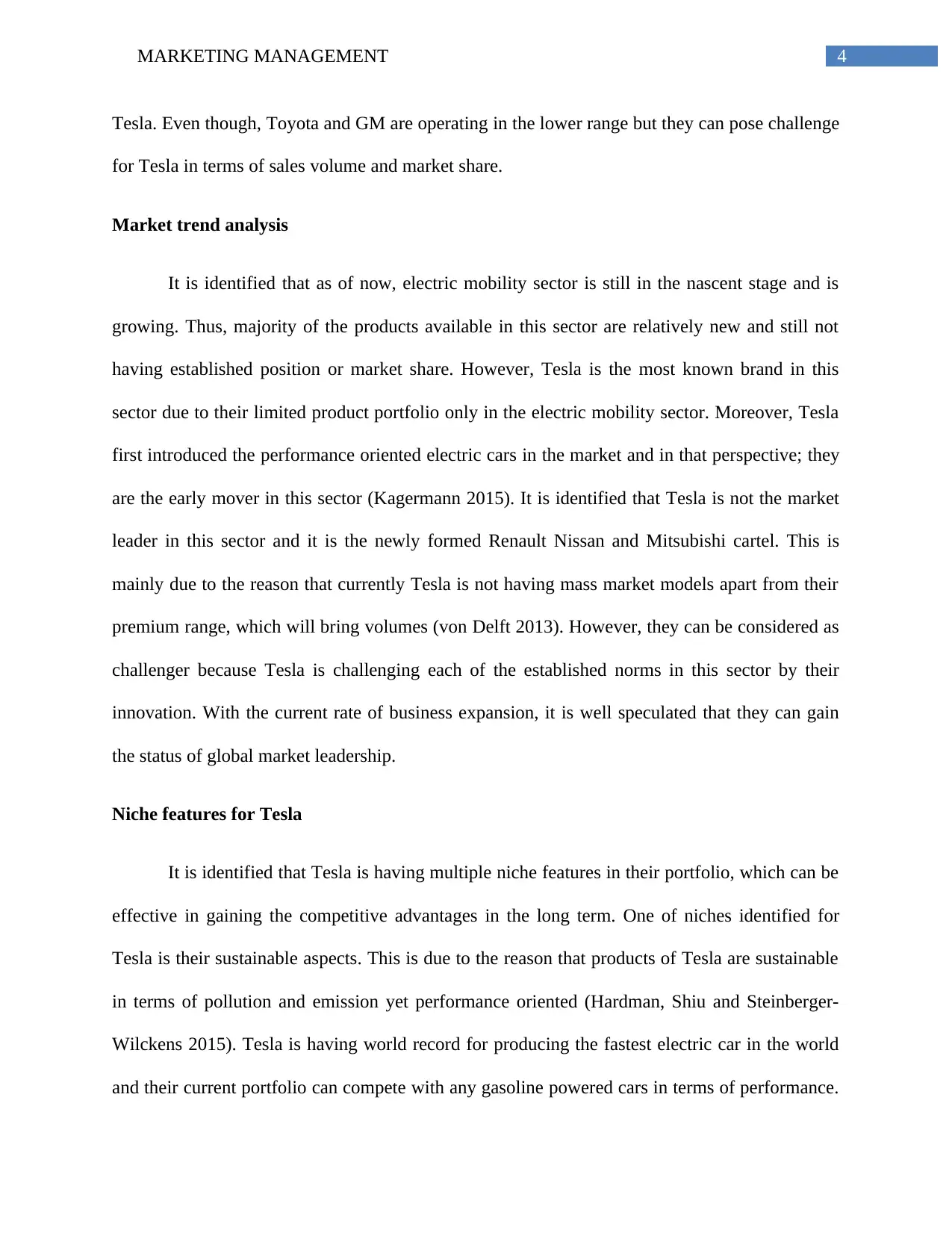
4MARKETING MANAGEMENT
Tesla. Even though, Toyota and GM are operating in the lower range but they can pose challenge
for Tesla in terms of sales volume and market share.
Market trend analysis
It is identified that as of now, electric mobility sector is still in the nascent stage and is
growing. Thus, majority of the products available in this sector are relatively new and still not
having established position or market share. However, Tesla is the most known brand in this
sector due to their limited product portfolio only in the electric mobility sector. Moreover, Tesla
first introduced the performance oriented electric cars in the market and in that perspective; they
are the early mover in this sector (Kagermann 2015). It is identified that Tesla is not the market
leader in this sector and it is the newly formed Renault Nissan and Mitsubishi cartel. This is
mainly due to the reason that currently Tesla is not having mass market models apart from their
premium range, which will bring volumes (von Delft 2013). However, they can be considered as
challenger because Tesla is challenging each of the established norms in this sector by their
innovation. With the current rate of business expansion, it is well speculated that they can gain
the status of global market leadership.
Niche features for Tesla
It is identified that Tesla is having multiple niche features in their portfolio, which can be
effective in gaining the competitive advantages in the long term. One of niches identified for
Tesla is their sustainable aspects. This is due to the reason that products of Tesla are sustainable
in terms of pollution and emission yet performance oriented (Hardman, Shiu and Steinberger-
Wilckens 2015). Tesla is having world record for producing the fastest electric car in the world
and their current portfolio can compete with any gasoline powered cars in terms of performance.
Tesla. Even though, Toyota and GM are operating in the lower range but they can pose challenge
for Tesla in terms of sales volume and market share.
Market trend analysis
It is identified that as of now, electric mobility sector is still in the nascent stage and is
growing. Thus, majority of the products available in this sector are relatively new and still not
having established position or market share. However, Tesla is the most known brand in this
sector due to their limited product portfolio only in the electric mobility sector. Moreover, Tesla
first introduced the performance oriented electric cars in the market and in that perspective; they
are the early mover in this sector (Kagermann 2015). It is identified that Tesla is not the market
leader in this sector and it is the newly formed Renault Nissan and Mitsubishi cartel. This is
mainly due to the reason that currently Tesla is not having mass market models apart from their
premium range, which will bring volumes (von Delft 2013). However, they can be considered as
challenger because Tesla is challenging each of the established norms in this sector by their
innovation. With the current rate of business expansion, it is well speculated that they can gain
the status of global market leadership.
Niche features for Tesla
It is identified that Tesla is having multiple niche features in their portfolio, which can be
effective in gaining the competitive advantages in the long term. One of niches identified for
Tesla is their sustainable aspects. This is due to the reason that products of Tesla are sustainable
in terms of pollution and emission yet performance oriented (Hardman, Shiu and Steinberger-
Wilckens 2015). Tesla is having world record for producing the fastest electric car in the world
and their current portfolio can compete with any gasoline powered cars in terms of performance.
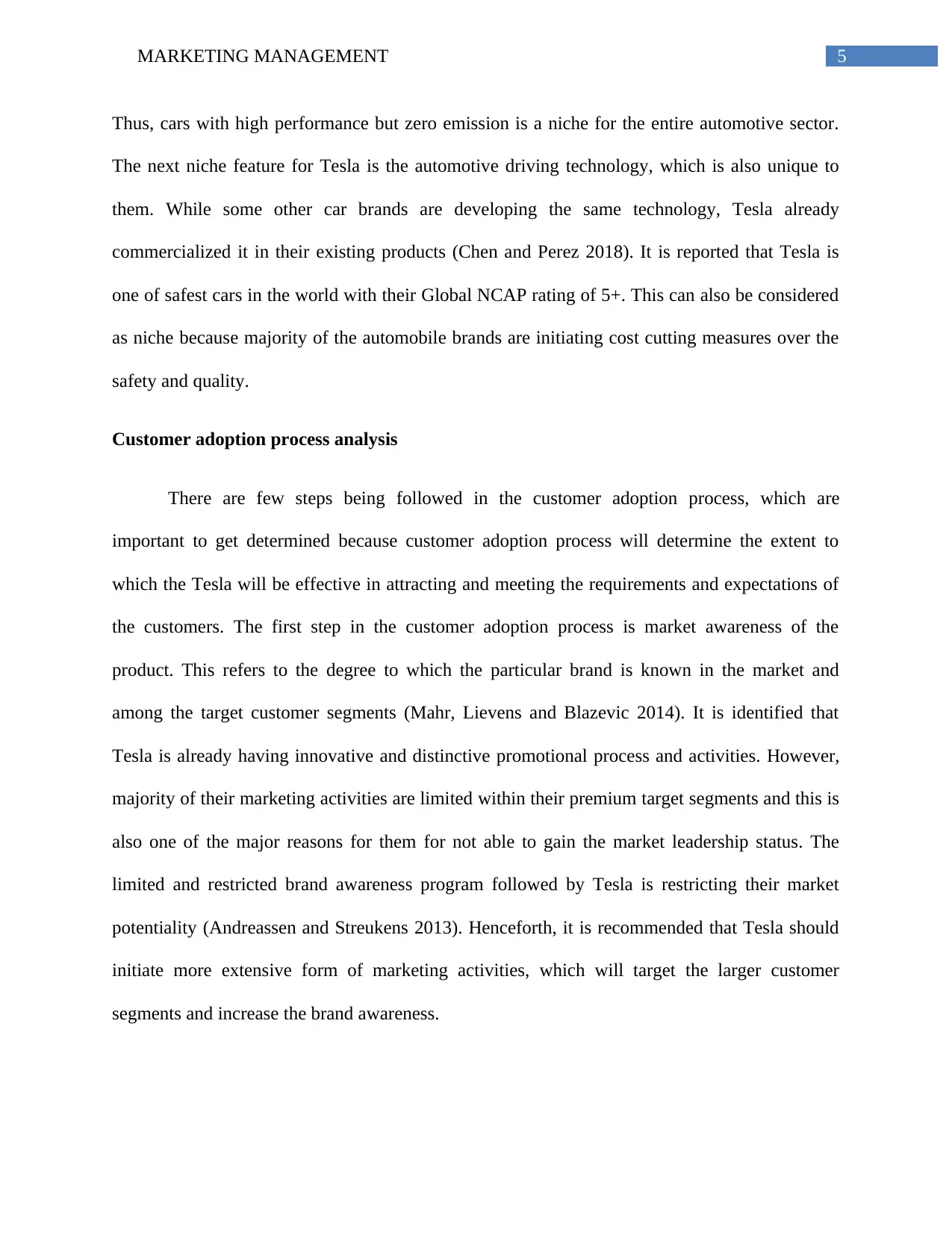
5MARKETING MANAGEMENT
Thus, cars with high performance but zero emission is a niche for the entire automotive sector.
The next niche feature for Tesla is the automotive driving technology, which is also unique to
them. While some other car brands are developing the same technology, Tesla already
commercialized it in their existing products (Chen and Perez 2018). It is reported that Tesla is
one of safest cars in the world with their Global NCAP rating of 5+. This can also be considered
as niche because majority of the automobile brands are initiating cost cutting measures over the
safety and quality.
Customer adoption process analysis
There are few steps being followed in the customer adoption process, which are
important to get determined because customer adoption process will determine the extent to
which the Tesla will be effective in attracting and meeting the requirements and expectations of
the customers. The first step in the customer adoption process is market awareness of the
product. This refers to the degree to which the particular brand is known in the market and
among the target customer segments (Mahr, Lievens and Blazevic 2014). It is identified that
Tesla is already having innovative and distinctive promotional process and activities. However,
majority of their marketing activities are limited within their premium target segments and this is
also one of the major reasons for them for not able to gain the market leadership status. The
limited and restricted brand awareness program followed by Tesla is restricting their market
potentiality (Andreassen and Streukens 2013). Henceforth, it is recommended that Tesla should
initiate more extensive form of marketing activities, which will target the larger customer
segments and increase the brand awareness.
Thus, cars with high performance but zero emission is a niche for the entire automotive sector.
The next niche feature for Tesla is the automotive driving technology, which is also unique to
them. While some other car brands are developing the same technology, Tesla already
commercialized it in their existing products (Chen and Perez 2018). It is reported that Tesla is
one of safest cars in the world with their Global NCAP rating of 5+. This can also be considered
as niche because majority of the automobile brands are initiating cost cutting measures over the
safety and quality.
Customer adoption process analysis
There are few steps being followed in the customer adoption process, which are
important to get determined because customer adoption process will determine the extent to
which the Tesla will be effective in attracting and meeting the requirements and expectations of
the customers. The first step in the customer adoption process is market awareness of the
product. This refers to the degree to which the particular brand is known in the market and
among the target customer segments (Mahr, Lievens and Blazevic 2014). It is identified that
Tesla is already having innovative and distinctive promotional process and activities. However,
majority of their marketing activities are limited within their premium target segments and this is
also one of the major reasons for them for not able to gain the market leadership status. The
limited and restricted brand awareness program followed by Tesla is restricting their market
potentiality (Andreassen and Streukens 2013). Henceforth, it is recommended that Tesla should
initiate more extensive form of marketing activities, which will target the larger customer
segments and increase the brand awareness.
⊘ This is a preview!⊘
Do you want full access?
Subscribe today to unlock all pages.

Trusted by 1+ million students worldwide
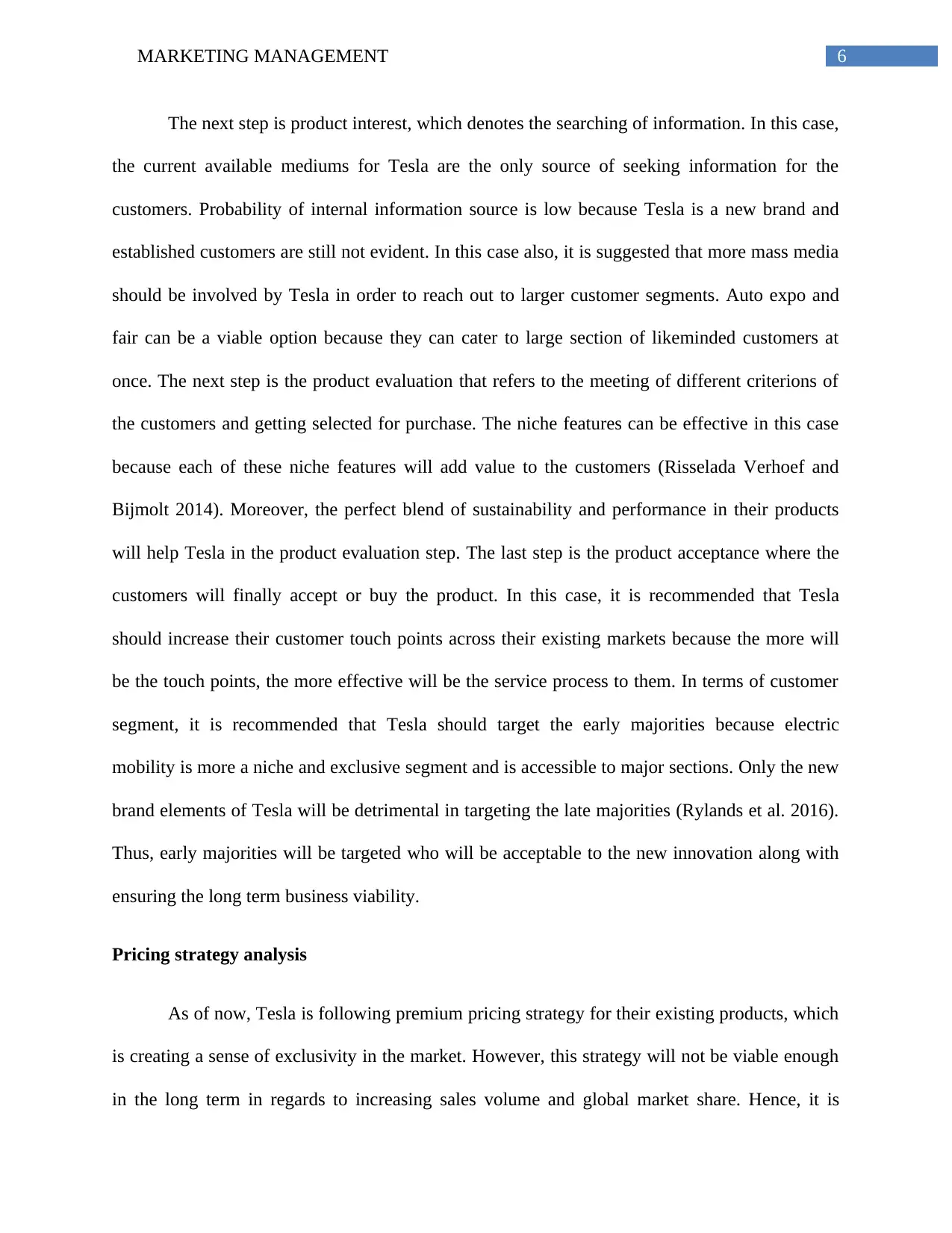
6MARKETING MANAGEMENT
The next step is product interest, which denotes the searching of information. In this case,
the current available mediums for Tesla are the only source of seeking information for the
customers. Probability of internal information source is low because Tesla is a new brand and
established customers are still not evident. In this case also, it is suggested that more mass media
should be involved by Tesla in order to reach out to larger customer segments. Auto expo and
fair can be a viable option because they can cater to large section of likeminded customers at
once. The next step is the product evaluation that refers to the meeting of different criterions of
the customers and getting selected for purchase. The niche features can be effective in this case
because each of these niche features will add value to the customers (Risselada Verhoef and
Bijmolt 2014). Moreover, the perfect blend of sustainability and performance in their products
will help Tesla in the product evaluation step. The last step is the product acceptance where the
customers will finally accept or buy the product. In this case, it is recommended that Tesla
should increase their customer touch points across their existing markets because the more will
be the touch points, the more effective will be the service process to them. In terms of customer
segment, it is recommended that Tesla should target the early majorities because electric
mobility is more a niche and exclusive segment and is accessible to major sections. Only the new
brand elements of Tesla will be detrimental in targeting the late majorities (Rylands et al. 2016).
Thus, early majorities will be targeted who will be acceptable to the new innovation along with
ensuring the long term business viability.
Pricing strategy analysis
As of now, Tesla is following premium pricing strategy for their existing products, which
is creating a sense of exclusivity in the market. However, this strategy will not be viable enough
in the long term in regards to increasing sales volume and global market share. Hence, it is
The next step is product interest, which denotes the searching of information. In this case,
the current available mediums for Tesla are the only source of seeking information for the
customers. Probability of internal information source is low because Tesla is a new brand and
established customers are still not evident. In this case also, it is suggested that more mass media
should be involved by Tesla in order to reach out to larger customer segments. Auto expo and
fair can be a viable option because they can cater to large section of likeminded customers at
once. The next step is the product evaluation that refers to the meeting of different criterions of
the customers and getting selected for purchase. The niche features can be effective in this case
because each of these niche features will add value to the customers (Risselada Verhoef and
Bijmolt 2014). Moreover, the perfect blend of sustainability and performance in their products
will help Tesla in the product evaluation step. The last step is the product acceptance where the
customers will finally accept or buy the product. In this case, it is recommended that Tesla
should increase their customer touch points across their existing markets because the more will
be the touch points, the more effective will be the service process to them. In terms of customer
segment, it is recommended that Tesla should target the early majorities because electric
mobility is more a niche and exclusive segment and is accessible to major sections. Only the new
brand elements of Tesla will be detrimental in targeting the late majorities (Rylands et al. 2016).
Thus, early majorities will be targeted who will be acceptable to the new innovation along with
ensuring the long term business viability.
Pricing strategy analysis
As of now, Tesla is following premium pricing strategy for their existing products, which
is creating a sense of exclusivity in the market. However, this strategy will not be viable enough
in the long term in regards to increasing sales volume and global market share. Hence, it is
Paraphrase This Document
Need a fresh take? Get an instant paraphrase of this document with our AI Paraphraser
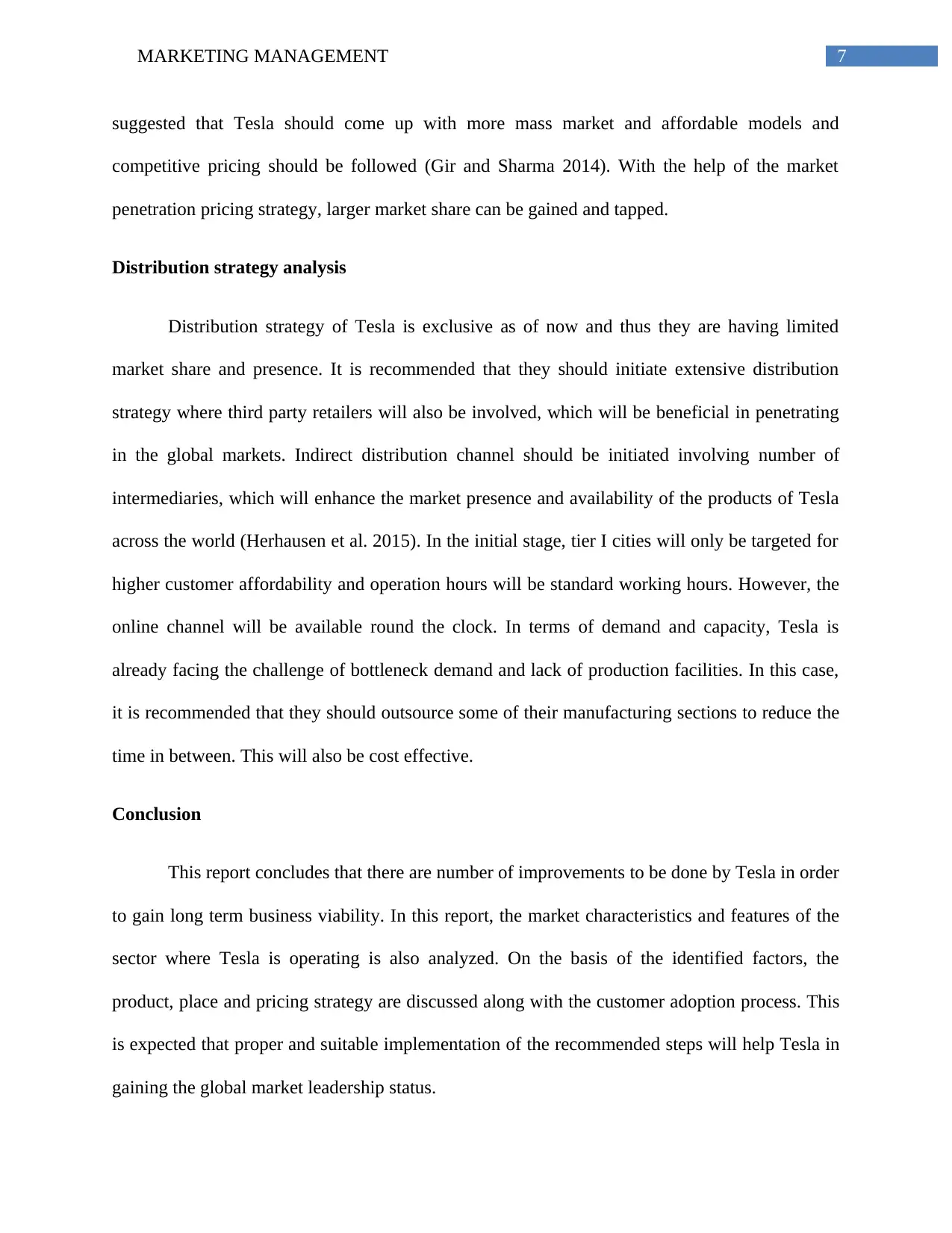
7MARKETING MANAGEMENT
suggested that Tesla should come up with more mass market and affordable models and
competitive pricing should be followed (Gir and Sharma 2014). With the help of the market
penetration pricing strategy, larger market share can be gained and tapped.
Distribution strategy analysis
Distribution strategy of Tesla is exclusive as of now and thus they are having limited
market share and presence. It is recommended that they should initiate extensive distribution
strategy where third party retailers will also be involved, which will be beneficial in penetrating
in the global markets. Indirect distribution channel should be initiated involving number of
intermediaries, which will enhance the market presence and availability of the products of Tesla
across the world (Herhausen et al. 2015). In the initial stage, tier I cities will only be targeted for
higher customer affordability and operation hours will be standard working hours. However, the
online channel will be available round the clock. In terms of demand and capacity, Tesla is
already facing the challenge of bottleneck demand and lack of production facilities. In this case,
it is recommended that they should outsource some of their manufacturing sections to reduce the
time in between. This will also be cost effective.
Conclusion
This report concludes that there are number of improvements to be done by Tesla in order
to gain long term business viability. In this report, the market characteristics and features of the
sector where Tesla is operating is also analyzed. On the basis of the identified factors, the
product, place and pricing strategy are discussed along with the customer adoption process. This
is expected that proper and suitable implementation of the recommended steps will help Tesla in
gaining the global market leadership status.
suggested that Tesla should come up with more mass market and affordable models and
competitive pricing should be followed (Gir and Sharma 2014). With the help of the market
penetration pricing strategy, larger market share can be gained and tapped.
Distribution strategy analysis
Distribution strategy of Tesla is exclusive as of now and thus they are having limited
market share and presence. It is recommended that they should initiate extensive distribution
strategy where third party retailers will also be involved, which will be beneficial in penetrating
in the global markets. Indirect distribution channel should be initiated involving number of
intermediaries, which will enhance the market presence and availability of the products of Tesla
across the world (Herhausen et al. 2015). In the initial stage, tier I cities will only be targeted for
higher customer affordability and operation hours will be standard working hours. However, the
online channel will be available round the clock. In terms of demand and capacity, Tesla is
already facing the challenge of bottleneck demand and lack of production facilities. In this case,
it is recommended that they should outsource some of their manufacturing sections to reduce the
time in between. This will also be cost effective.
Conclusion
This report concludes that there are number of improvements to be done by Tesla in order
to gain long term business viability. In this report, the market characteristics and features of the
sector where Tesla is operating is also analyzed. On the basis of the identified factors, the
product, place and pricing strategy are discussed along with the customer adoption process. This
is expected that proper and suitable implementation of the recommended steps will help Tesla in
gaining the global market leadership status.

8MARKETING MANAGEMENT
⊘ This is a preview!⊘
Do you want full access?
Subscribe today to unlock all pages.

Trusted by 1+ million students worldwide
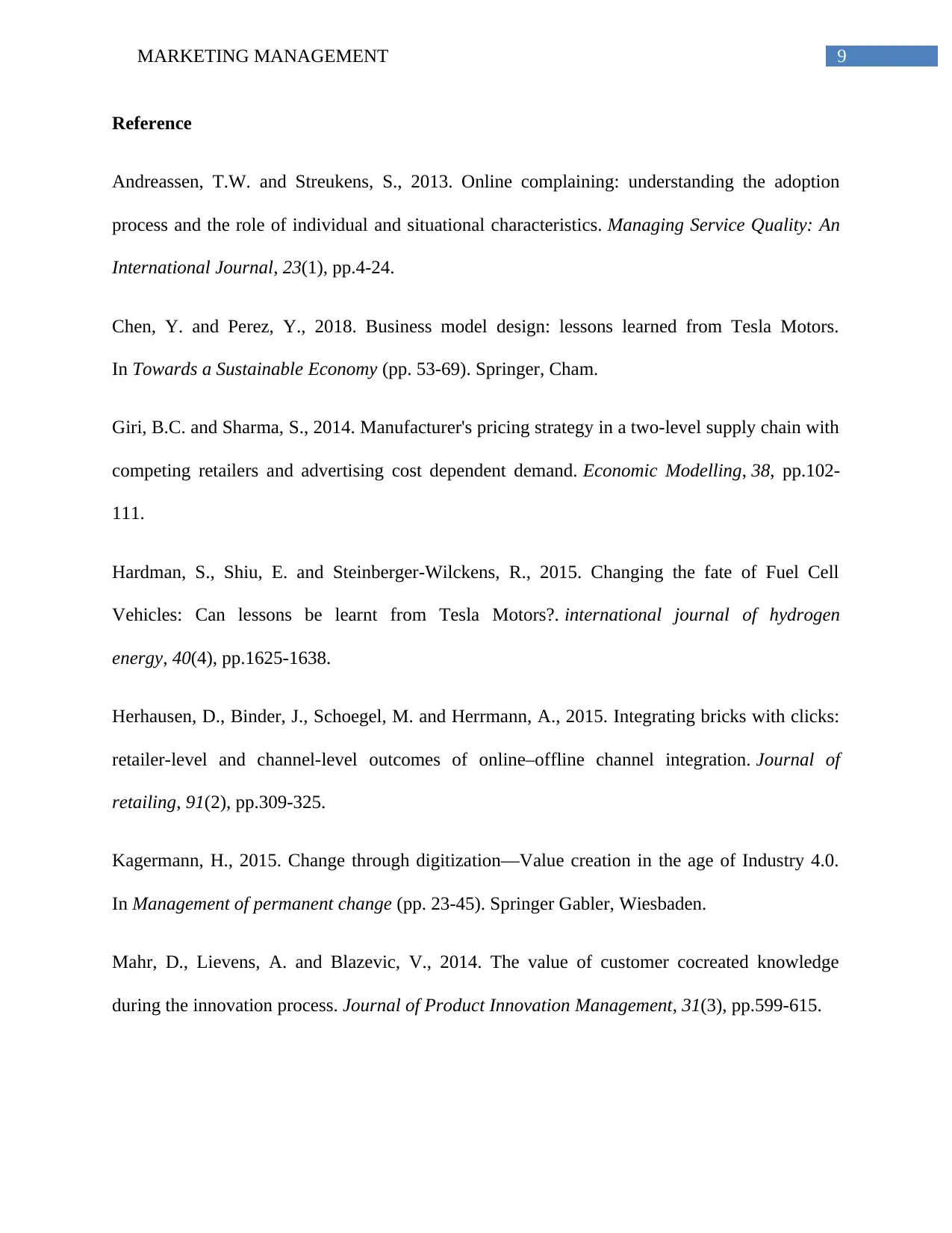
9MARKETING MANAGEMENT
Reference
Andreassen, T.W. and Streukens, S., 2013. Online complaining: understanding the adoption
process and the role of individual and situational characteristics. Managing Service Quality: An
International Journal, 23(1), pp.4-24.
Chen, Y. and Perez, Y., 2018. Business model design: lessons learned from Tesla Motors.
In Towards a Sustainable Economy (pp. 53-69). Springer, Cham.
Giri, B.C. and Sharma, S., 2014. Manufacturer's pricing strategy in a two-level supply chain with
competing retailers and advertising cost dependent demand. Economic Modelling, 38, pp.102-
111.
Hardman, S., Shiu, E. and Steinberger-Wilckens, R., 2015. Changing the fate of Fuel Cell
Vehicles: Can lessons be learnt from Tesla Motors?. international journal of hydrogen
energy, 40(4), pp.1625-1638.
Herhausen, D., Binder, J., Schoegel, M. and Herrmann, A., 2015. Integrating bricks with clicks:
retailer-level and channel-level outcomes of online–offline channel integration. Journal of
retailing, 91(2), pp.309-325.
Kagermann, H., 2015. Change through digitization—Value creation in the age of Industry 4.0.
In Management of permanent change (pp. 23-45). Springer Gabler, Wiesbaden.
Mahr, D., Lievens, A. and Blazevic, V., 2014. The value of customer cocreated knowledge
during the innovation process. Journal of Product Innovation Management, 31(3), pp.599-615.
Reference
Andreassen, T.W. and Streukens, S., 2013. Online complaining: understanding the adoption
process and the role of individual and situational characteristics. Managing Service Quality: An
International Journal, 23(1), pp.4-24.
Chen, Y. and Perez, Y., 2018. Business model design: lessons learned from Tesla Motors.
In Towards a Sustainable Economy (pp. 53-69). Springer, Cham.
Giri, B.C. and Sharma, S., 2014. Manufacturer's pricing strategy in a two-level supply chain with
competing retailers and advertising cost dependent demand. Economic Modelling, 38, pp.102-
111.
Hardman, S., Shiu, E. and Steinberger-Wilckens, R., 2015. Changing the fate of Fuel Cell
Vehicles: Can lessons be learnt from Tesla Motors?. international journal of hydrogen
energy, 40(4), pp.1625-1638.
Herhausen, D., Binder, J., Schoegel, M. and Herrmann, A., 2015. Integrating bricks with clicks:
retailer-level and channel-level outcomes of online–offline channel integration. Journal of
retailing, 91(2), pp.309-325.
Kagermann, H., 2015. Change through digitization—Value creation in the age of Industry 4.0.
In Management of permanent change (pp. 23-45). Springer Gabler, Wiesbaden.
Mahr, D., Lievens, A. and Blazevic, V., 2014. The value of customer cocreated knowledge
during the innovation process. Journal of Product Innovation Management, 31(3), pp.599-615.
Paraphrase This Document
Need a fresh take? Get an instant paraphrase of this document with our AI Paraphraser
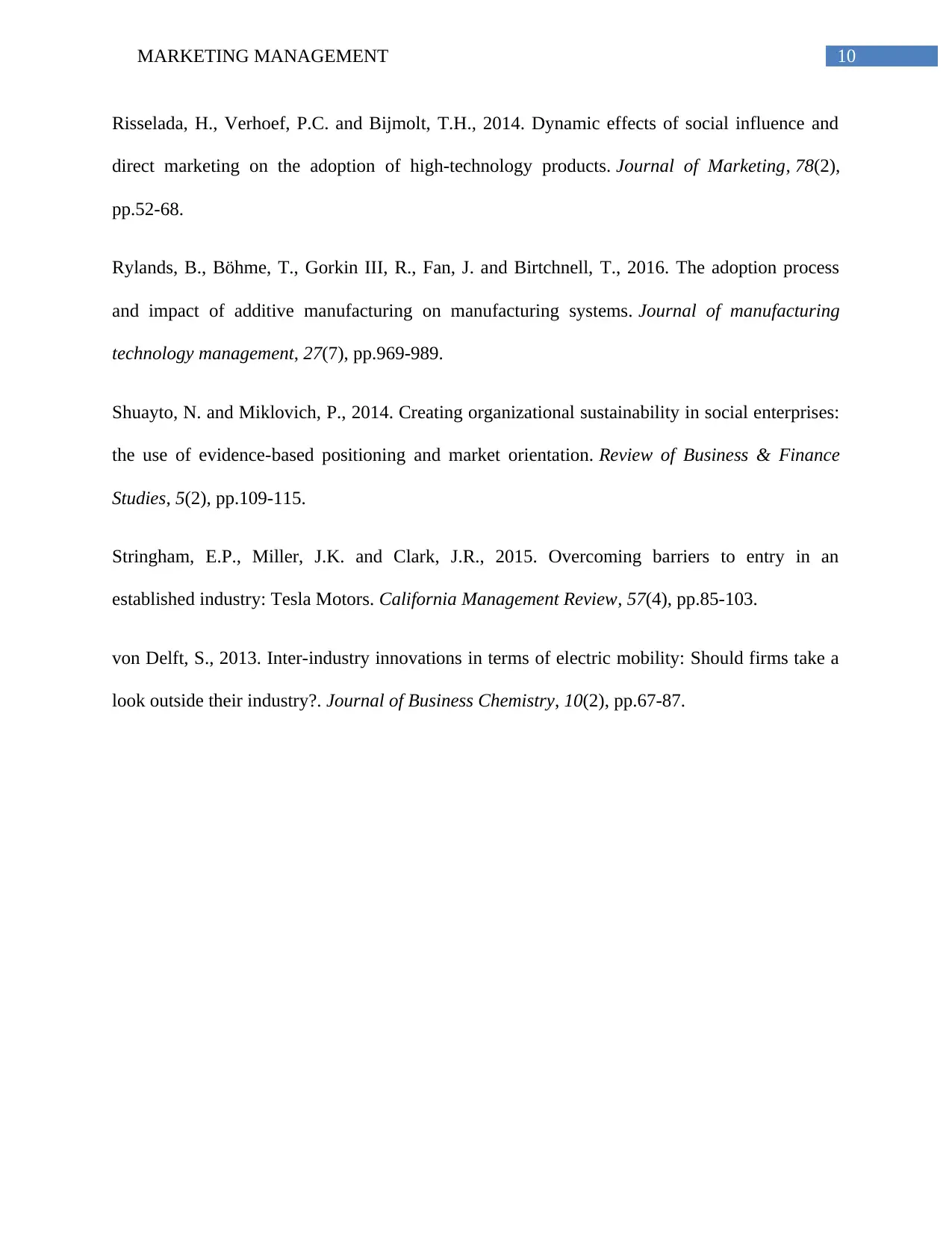
10MARKETING MANAGEMENT
Risselada, H., Verhoef, P.C. and Bijmolt, T.H., 2014. Dynamic effects of social influence and
direct marketing on the adoption of high-technology products. Journal of Marketing, 78(2),
pp.52-68.
Rylands, B., Böhme, T., Gorkin III, R., Fan, J. and Birtchnell, T., 2016. The adoption process
and impact of additive manufacturing on manufacturing systems. Journal of manufacturing
technology management, 27(7), pp.969-989.
Shuayto, N. and Miklovich, P., 2014. Creating organizational sustainability in social enterprises:
the use of evidence-based positioning and market orientation. Review of Business & Finance
Studies, 5(2), pp.109-115.
Stringham, E.P., Miller, J.K. and Clark, J.R., 2015. Overcoming barriers to entry in an
established industry: Tesla Motors. California Management Review, 57(4), pp.85-103.
von Delft, S., 2013. Inter-industry innovations in terms of electric mobility: Should firms take a
look outside their industry?. Journal of Business Chemistry, 10(2), pp.67-87.
Risselada, H., Verhoef, P.C. and Bijmolt, T.H., 2014. Dynamic effects of social influence and
direct marketing on the adoption of high-technology products. Journal of Marketing, 78(2),
pp.52-68.
Rylands, B., Böhme, T., Gorkin III, R., Fan, J. and Birtchnell, T., 2016. The adoption process
and impact of additive manufacturing on manufacturing systems. Journal of manufacturing
technology management, 27(7), pp.969-989.
Shuayto, N. and Miklovich, P., 2014. Creating organizational sustainability in social enterprises:
the use of evidence-based positioning and market orientation. Review of Business & Finance
Studies, 5(2), pp.109-115.
Stringham, E.P., Miller, J.K. and Clark, J.R., 2015. Overcoming barriers to entry in an
established industry: Tesla Motors. California Management Review, 57(4), pp.85-103.
von Delft, S., 2013. Inter-industry innovations in terms of electric mobility: Should firms take a
look outside their industry?. Journal of Business Chemistry, 10(2), pp.67-87.
1 out of 11
Related Documents
Your All-in-One AI-Powered Toolkit for Academic Success.
+13062052269
info@desklib.com
Available 24*7 on WhatsApp / Email
![[object Object]](/_next/static/media/star-bottom.7253800d.svg)
Unlock your academic potential
Copyright © 2020–2025 A2Z Services. All Rights Reserved. Developed and managed by ZUCOL.





